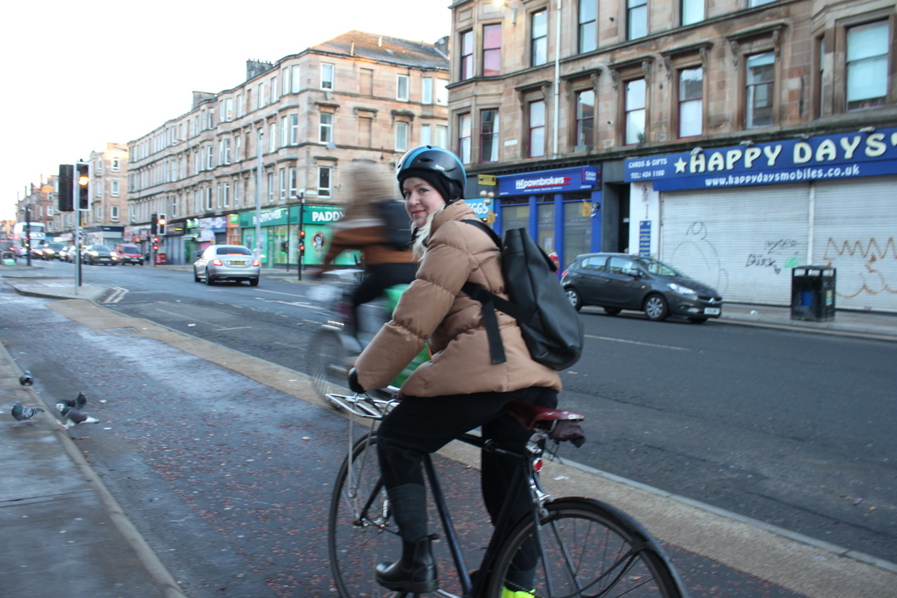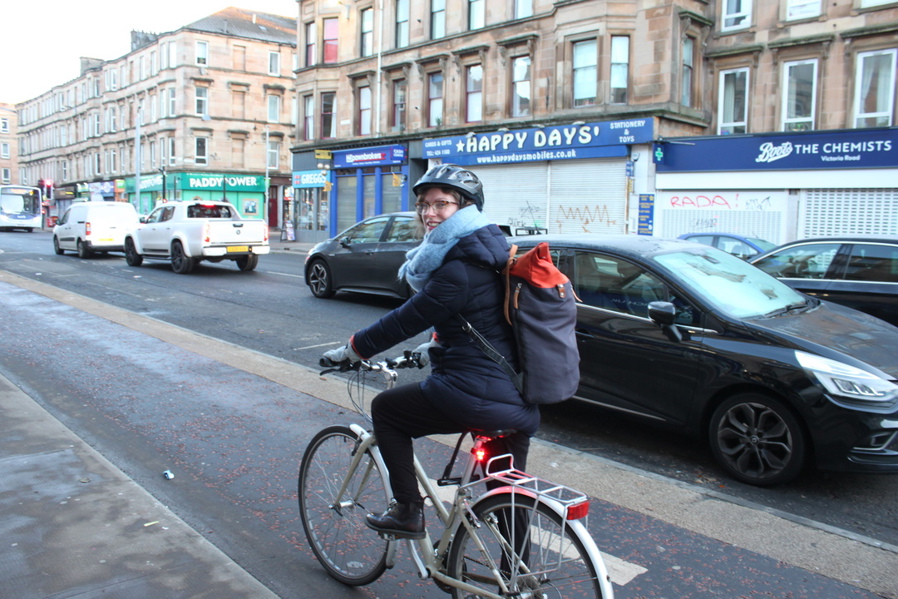
A new landmark cycle route in Glasgow which aims to help make it easier for more people to cycle is seeing massive levels of people travelling by bike, following its completion this summer.
Over a 48-hour period between 20th and 21st September 2023, traffic surveys organised by Cycling Scotland recorded 3,739 bikes travelling along the route on Victoria Road in the South of Glasgow, out of a total of 29,318 travel methods recorded. This means that 12.75% of people cycled their journey.
The South City Way is one of the most ambitious urban cycle routes in the country, showcases cycling infrastructure being recognised as a national priority and kickstarts transformation for cycling in Scotland. Running for 2.5km, it’s a fully separated, two-way on-street cycle path, providing a high-quality direct and safe link between communities in Glasgow’s Southside and the city centre. The route was developed by Glasgow City Council and Sustrans, with funding from the Scottish Government and cross-party support.
Comparing this result to a street without safe cycle lanes, Cathedral Street in Glasgow showed just 1.69% of people cycling their journey.
Cycling Scotland organises traffic surveys across Scotland to monitor changes in travel behaviour, working in partnership with all 32 local authorities at over 100 locations. Conducted biannually in May and September each year, these nationwide traffic surveys help to track changes in modal share, highlighting how new high-quality cycle routes such as this are supporting more people to make sustainable journeys.
The Autumn 2023 traffic surveys on Victoria Road also revealed that cycling volumes at the location are at their highest during commuting times, with more bikes heading northbound towards the city centre in the morning and returning southbound in the afternoon commuting period.
Robin Ellis, a commuter who cycles to her work along the South City Way several times a week, said:
“A lot of the roads in the area are filled with so many large vehicles, lorries and commuter traffic, so it makes a massive difference to be able to take the cycle route and feel a lot safer and protected. The route’s also much quicker than any other way of getting to work.”
Jen Symington, another frequent user of the route, said:
“I use the cycle path most days to travel to work, and I feel safer using it. I’m six months pregnant and it’s been helping me to keep cycling. I avoid using roads and I feel safer using a space like this that’s just for bikes.”
“I like that cycling helps me to keep active and get some exercise without setting aside a specific time. It’s better for the environment and I’ve got more control over my times when I’m travelling to work.”

Minister for Active Travel Patrick Harvie, said:
“These new figures from Cycling Scotland continue to prove that where we invest in high quality cycling lanes, we make it easier for more people to choose cycling for everyday journeys.
“I’m really pleased to see the success of the South City Way, which is just the beginning of Glasgow City Council’s ambition to build a comprehensive network to make cycling safer and more accessible for everyone.
“To support these ambitions of our towns and cities, the Scottish Government will continue to invest in high quality walking, wheeling and cycling infrastructure. In doing so, we can transform how people choose to get around and ensure that more people, in more communities right across the country, can benefit from healthier and happier transport options.”
Keith Irving, Chief Executive of Cycling Scotland, said:
“It’s really exciting to record this high level of people cycling on the South City Way in Glasgow, and demonstrates that building a network of safe, connected and direct cycling lanes means more people travel by bike. This is the clearest evidence yet that when Scotland builds good quality cycling infrastructure, it gets more people cycling, cutting emissions.
“Two years after Scotland hosted Cop26, this is the type of project essential to cut emissions in cities. With transport the largest source of carbon emissions in Scotland, we need to help more people to cycle, walk and wheel safely. Investing in dedicated, separated cycling lanes, limiting polluting traffic growth and providing support for everyone to access bikes, training and bike storage are all key actions to reduce our climate impact and improve health. We need more safe cycling routes, like the South City Way, across Scotland.”
Councillor Angus Millar, City Convener for Transport, said: “The South City Way is making a remarkable difference to everyday journeys in the city’s Southside. These figures show without a shadow of doubt that when we make it safer to do so, more and more people want to travel by bike.
“The success of South City Way just adds impetus to our efforts to create a City Network for active travel that ensures safe, segregated infrastructure for cycling all across Glasgow. Work on the final, city centre leg of the South City Way has now started and construction on the first phase of Connecting Battlefield, which will link with the South City way, will start in the new year.
“Cycling infrastructure is connecting up across Glasgow, growing the places in the city that are increasingly safer to reach by bike. By creating the correct conditions for safer cycling, we are supporting the shift to sustainable transport that is essential if we are to reduce the city’s carbon emissions.”
Karen McGregor, Scotland Director at Sustrans, added:
“These figures from the South City Way speak for themselves – making it safer and easier to walk, wheel and cycle means more people make healthier and greener journeys. With 13% of journeys along Victoria Road now being made by bike, the South City Way shows the level of demand we can unlock with well-designed infrastructure that puts people first.
"It's now vital that investment builds on this success, giving more communities across Scotland the same opportunities to benefit from high-quality networks which make walking, wheeling and cycling the safe, obvious choices for everyday journeys.”
Further data on cycle rates in Scotland can be found on the Cycling Open Data Portal.
Explanation of methodology:
- Cycling Scotland conducts traffic surveys at over 100 locations across Scotland’s 32 local authorities. The surveys are organised twice a year in May and September, and count all modes of traffic on roads, footways and pavements over a 48-hour period (on Wednesdays and Thursdays). Video cameras are mounted onto existing street furniture and film. The cameras film at a low quality so no personal identifying information can be detected. The surveys have been running in some locations since 2017. This is the first traffic survey conducted at Victoria Road. The next survey will take place in May 2024.
Cycling volumes recorded:
- Cycling volumes were recorded as increasing at this location during commuting times, with more bikes heading northbound towards the city centre in the morning and returning southbound in the afternoon commuting period. Combining data from Wednesday 20th and Thursday 21st September, between 07:00-09:00 92% of bikes counted were travelling north towards Glasgow city centre. Between 16:00-18:30, 77% of bike traffic was travelling south.
Links to data: